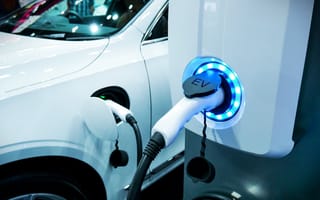Forty years ago, thinking about the new frontier of cars in 2023 triggered fantasies of cartoonish levitating vehicles flitting from bubble pod to bubble pod or starship cruisers zipping through the atmosphere. And while we haven’t quite reached the glamorized imaginations behind The Jetsons or Star Wars, the progress modern transportation has made should not go unrecognized.
In fact, the current state of vehicles is a lot more futuristic than one might think.
After decades of relying solely on fossil fuels to power our cars, the introduction of rechargeable electric vehicles has not only provided an efficient way to cut back on burning finite resources but has also saved drivers money as gas prices reach record highs. And unlike gas-powered cars, electric motors produce peak torque from a standstill position by eliminating the need for buildup that gas engines require to reach maximum power.
With reduced fueling costs and innovative new features adding excitement to everyday driving, consumers are taking notice. According to a January market insight report from Statista, revenue in the U.S. electric vehicles market is projected to reach more than $61 billion in 2023.
At parking infrastructure startup FLASH, product designers are taking big swings as the electric vehicle market continues to expand across the country. By streamlining the process of charging an electric vehicle through new features like port reservations and up-front cost estimates, the company is on a mission to turn futuristic concepts into a smooth daily reality for customers.
Built In Austin sat down with Senior Director of Product Design Jessica Weissberg to learn what’s on the horizon at FLASH and all the ways implementing user feedback is elevating the future of transportation to new heights.
FLASH is a cloud-native startup that provides technology for parking garages across the U.S. and Canada.
Describe a project you’re working on right now in the transportation space. Why is this exciting from a tech perspective?
At FLASH, we are leveraging our existing partnerships and parking infrastructure to deliver a seamless electric vehicle (EV) charging experience. As a new EV driver myself, I understand that the transition to EV and the convenience of charging can be a concern for drivers. We aim to provide an experience that is intuitive, reliable and convenient whether it starts at home, during your commute or at your destination. I’m excited about this initiative because we are at the forefront of one of the most influential emerging technologies in automotive history.
How do you determine what people really want out of a transportation tech product or service from a UX and design perspective?
To ensure that our product meets the needs and preferences of our users, we place them at the center of everything we do. Leveraging data, research and a continuous process of testing and iteration helps us create a truly user-centric experience.
For instance, during an analysis of our product journey, we carefully considered various factors that could influence our users’ experience to identify critical points of interaction. We conducted a field study along with A/B testing and identified an opportunity to improve payment and wayfinding signage at parking facilities. Our goal was to make the parking and payment experience more discoverable and intuitive. This exercise also surfaced a drop-off in our EV charging process, which led the team to gather user feedback and do competitive analysis.
We discovered pricing information may not have surfaced early enough in the journey, so we made small adjustments to provide the right information at the right time. This iterative approach allows us to continuously learn and improve upon smaller parts, which make up the larger initiative, ensuring that we’re able to meet the needs of our users in the rapidly evolving transportation space.
To ensure that our product meets the needs and preferences of our users, we place them at the center of everything we do.”
How do you design for products with long timelines and large capital investment requirements?
Designing products that require significant investment also requires careful planning. I find it helpful to hold discovery sessions or design sprints with stakeholders. This helps surface critical business questions early on and lets the team conceptualize experiences that consider both digital and physical user interactions.
An early milestone for our EV reservations was to develop a working, testable concept. To minimize effort, we focused on one location and built on our existing parking reservation functionality, enabling users to add charging reservations as an additional service. We leveraged the insight and feedback gained during the initial release to inform future milestones while keeping our ultimate vision in mind.
We also studied the latest available technologies and AI capabilities of the EV charging infrastructure. With our user-centric, data-backed vision, we designed a phased approach that would allow us to test and gather feedback at each stage before making significant financial commitments. This approach allows continuous iteration without significant engineering lift and avoids unexpected user responses, helping us effectively manage our budget over the long term.







